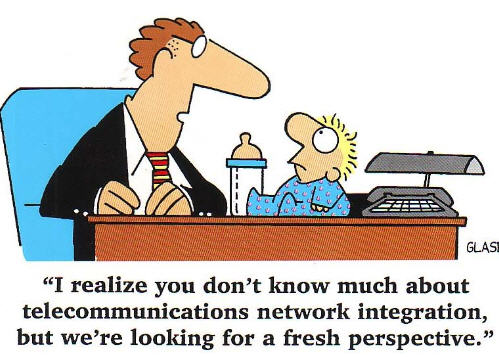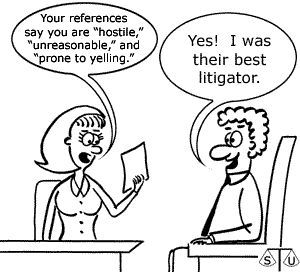|
Areas:
Portfolio
č • |
|
Simulation & Gaming: +++
|
Memos &
portfolios
|
|
Your role |
To whom |
Write as ... |
|
As coach |
Your candidate |
Use the 2nd person singular = You. You write to the candidate for whom you were a coach. |
|
As candidate |
Yourself |
Use the 1st person singular = I. You write to yourself. |
|
As company / recruiter |
People in general |
Use the 3rd person plural = They. You write to people in general, to an unspecified audience, as if you were writing an instruction manual, based on what you saw in the series of interviews in the session. You write from the point of view of a recruiter. |
| As observer * | People in general |
1st person = You. You write a 'mini memo', one to each of the candidates whom you observed. Put your mini memos inside one ordinary memo (one single document). You should if it is appropriate, write general things first, points common to all the candidates, and then specific things for eachg of the candidates. Your view is important, as coaches tend to be too kind to their own candidates. So be as harsh as possible, without being aggressive. |
After the course, you will need to provide the above memos, and also write two additional můemos: (a) a memo in your role as learner and (b) a memo on how environmental issues will affect your carerr. These goes into your portfolio.
|
As learner |
To your trainer |
For your portfolio, at the end of the course. |
| As sustainable professional | To your trainer | For your portfolio, at the end of the course. |
Make sure that you write your memos exactly as indicated below (e.g., with correct headers, recipients, memo ID, style). Follow the models (templates) below. Indicate the date for each memo. Failure to do so will result in a lower grade.
RE: How to write your memos (trainer's memo to trainees) Write memos about your interview experience . Language level (e.g., in English) is not a concern, unless it was a major problem in the interview. Due date: Always bring a copy of your memo to the next class; it may be on paper or in your computer. That is, the class immediately following the class to which your memo refers. In other words, you will write a memo after every interview session. If you are a coach, you should also give a copy to your candidate. Models: Below are models of the memos that you should write Italics give examples of the sort of thing to write; you write your own things. Use the headings given in the notes below; use the correct memo titles and letters - a and b. Use your own layout. Write in the real names of the people concerned (for example, for your candidate); delete indicators such as "your candidate". Do not forget to put in the correct names for From, To and CC. Use FirstName FAMILY NAME format. Language & style: You may write in English or in French or in a mixture of both. Use short phrases and keywords; do not write a book! Focus on the main points, and write concisely. Memos must be typed (using a computer; no hand-written memos). Length: One page maximum per memo; use 1.3 spacing. Use a separator (such as ++++++++++) between each memo, not a new page. Number of copies: The models below indicate the number of copies that you need to make during the course. Archive: Keep an electronic copy. You will need to these copies to make your end-of-course portfolio. During the course, do not send by email to your trainer. Memo numbers: Make sure that you include all header information for each memo, including the title. If you use your head and the models below, you will have little difficulty. The memos are listed below. |
Make sure that you include all the information given here, including the titles, such as "Memo as coach", and layed out as here. Remember that you will do one memo for each interview in which you were involved (as candidate, coach, recruiter, observer, ...). In some courses, notably the SEDI, you will do two series of three interviews (each with three or more memos).
or Memo as coach, series 2*
From: You (coach):
_________
To: Your candidate
(name the person):___________
CC: Your trainer:
_________
Date of interview:
_________ (date in format dd mmm, yyyy, ex. 14 Dec, 1789)
Date of video analysis: _________
Date of memo: _________
Length of time spent looking at the video and doing
the analysis: ___
Place where the video was viewed and analysed: _________
RE: Strong points and improvements that my client candidate should make.
Strong points: (2 to 4)
Aspects to improve and how
Your learning
* Series 1 or Series 2 may not apply to you. Check before you write.
or Memo as candidate, series 2
From:
You (trainee candidate): _________
To:
Me (myself)
____________
CC: Your trainer ______
Date of interview:
_________ (date in format dd mmm, yyyy, ex. 14 Dec, 1789)
Date of video analysis: _________
Date of memo: _________
Length of time spent looking at the video and doing
the analysis: ___
Place where the video was viewed and analysed: _________
RE: Strong points & aspects
for me to improve as candidate;
Based on debriefing with my coach (their
name ____________)
Strong points: (2 to 4)
Include here one screen shot, from your recording, that illustrates what you say.

Aspects to improve, and how to improve: (3 to 5)
Include here two or more screen shots that illustrate what you say.



.jpg)
Memos as company recruter, series 2
From: You (company/observer).
Specify if you were recruiter.
To: People in
general.
CC: Your trainer
___
Date of interviews:
___
Date of memo: ___
RE: Comments on being an interviewer
What general things I learned, from the point of view of a company (interviewer), that candidates should consider before, during and after an interview: (3 to 5 things)
Memos as observer, series 2
From: You (observer)
_____________
To: Candidates (name each
candidate) _________________________________
CC: Your trainer
___
Date of interviews:
___
Date of memo: ___
RE: Comments on being an observer
A. What general things I observed, common to all candidates, and that candidates should consider before, during and after an interview: (3 to 5 things).
B. What specific things I observed in each candidate, and that s/he should consider before, during and after an interview: (3 to 5 things for each candidate)
Person 1
Person 2
Person 3
+++++++++++++++++++++++++++++++++++++++++++++++++++++++++
+++++++++++++++++++++++++++++++++++++++++++++++++++++++++
Soon after the last class of your training course, you will need to put all your memos together, add some things, and make a portfolio to hand in to your trainer. This section tells you how to do this.
You portfolio file will contain the following elements, in the following order:
- Cover sheet - one page maximum; do not use more than one single A4 size page!
- Memo as learner (trainee).
- Memos (as indicated above). For SEDI courses, memos for each series together, as above.
- LinkedIn profile.
- Video analysis.
- Job ad.
- Presentation / film. Provide only slides in miniature (six per page), not full size.
- Log sheet (scanned); if your class did not have a log sheet, indicate this at the bottom of the cover sheet.
- Other.
Details of each element are provided below.
1. Cover sheet. The start of your portfolio should be a maximum of one single A4 page. It will include the following items:
| a | b | c % presence | d | e | f | g | h |
| Session |
Date |
Present
100 |
Participation level |
Your role |
Coach for (the person whom you coached): Coached by (the person who coached you): |
Extra points |
Memo? y=1 n=0 |
| 1 | |||||||
| 2 | |||||||
| 3 | |||||||
| 4 | |||||||
| 5 | |||||||
| 6 | |||||||
| 7 | |||||||
| 8 | |||||||
| ... | |||||||
|
Means: |
Totals: |
Notes:
Col a. For some courses, you may have done two or more sessions in one class. For example, whole class for the first hour or so, then half the class in the second session, or you may have done a session of interviews, followed on the same day by a session of presentations. Each one counts as a session. Thus you may have more sessions than you had classes. Make sure that you list the sessions.
SEDI courses have 9 rows: 1 Intro session; 2,3,4 Series 1 interview training (3 sessions); 5 Middle feedback; 6,7,8 Series 2 interview training (3 sessions); 9 Final session.
Col c. % presence. Rough estimate, rounded to nearest 10%. If you arrived 30m late for a 90m class, then you mark 30%; if you were 20m late out of 90mm, mark 20%. If you left early, same thing. Do not attempt to paste over late arrivals in class. Indicate the mean of the column, rounded to the nearest 10.
Col d. Levels of participation: 4 Maximum (use only twice); 3 High; 2 Good; 1 Average; 0 Low. If you were absent, indicate 'absent'. If you spent most of the class fiddling with your electronic device, then you need to indicate 0.5. Indicate the mean of the column, rounded to the nearest whole number.
Col e. @ If you did a presentation or showed a film, indicate this in a new line, even if this is the same date as an interview session. Your role was then 'Presenter'. You will then have two lines with the same date. Be sure to include your ppt slides (in miniature) at the end of the portfolio).
Col f. If your role, in col e, was candidate, then put the name of your coach in col f.
If your role, col e, was coach, then put the name of your candidate in col f.Col g. These are additional points that you obtained if you were selected as candidate or if you were the coach of the selected candidate. They correspond to the extra points indicated on your log sheet. N° 1 candidate = 9 points; Coach = 4 points.
Col h. Indicate here if you showed your memo on time in the following class.
The cover sheet, with
all the above elements, including the table, on one single page,
are necessary.
2a. Memo as learner. Write a memo about your experience as trainee in the course. Indications are provided below. (Italics are examples only; you write your own stuff.)
Use person according to proposition.
From: You (learner). _________
To: Your trainer. _________
Date on which you write: ___ (format dd mmm, yyyy, ex. 14 Dec, 1789)RE: Comments on the job interviews training sessions
This section is important. Make sure that you reply fully to all questions.
Importance
A few words about how important you think job interviews are among all the things that are important in finding a job. Mention three to four other things that are also important. Rank order job interviews and the other things. Support your opinion with reference to a written document - incl URL, document reference. Document can be written or video.
Learning
Indicate specific, concrete things that you learned during the course, as follows. Do not say such things as "I learnt to be a better candidate" - you will loose marks! Imagine that these are your answers in a job interview.
Interview things. Two to four of the most important things that you learned about job interviews and you in job interviews. List with numbers: 1., 2., etc. Use from 3 to 7 lines for each thing.
Personal things. Two to three most important things that you leaned about yourself as a person (irrespective of job interviews).
Learning things. Two to three most important things that you learned about your learning preferences, styles and processes. For example, learning by doing, learning by reflecting (thinking, talking, sharing) on/about your performance (experience), learning by getting feedback (video, freind), being able to try again, learning from books/lectures, etc.
Simulation. Two or three important things about your experience participating in simulations (simulated job inyterviews). For example, low stakes, low threat, full and/or immediate feedback, lack of realisim, comparison with real-world interviews, etc.
Improvements . If you were lucky enough to have two interviews during the course, please indicate two or three things that you think improved. They can be of any kind. If you had only one interview, then this item will be difficult to do. However, you can if you wish, imagine, maybe based on observation or coaching that you did. If only one interview, make sure that you indicate here that your opinion is based on imagination -- maybe on what you imagine that you would be like in a second interview.
Reading & comment
Download some of the texts on my web site or in my Google Drive, do the following:
List the texts (Author. Title. Source (web sire, drive).
Choose two or three, and explain briefly why you chose those two.
Explain briefly:
(a) how the texts are relevant to your job inteview skill training, and
(b) how they will help you improve your job interview skills.
Commitment
Indicate two or three things that you commit (promise) yourself to do in preparation for a real job interview when one comes up in the future. Indicate reasons you chose those 2 or 3 things.
Indicate two or three things that you commit (promise) yourself to do during a real job interview when one comes up in the future. Indicate reasons you chose those 2 or 3 things.
Behaviour
One to three aspects of your attitude and/or behaviour in class that were positive and/or helpful to others or to yourself.
One to two aspects of your attitude and/or behaviour in class that were negative and/or unhelpful to others or to yourself. For each of the aspects briefly describe (a) how you should have behaved and (b) how you intend to behave in the future.
A short statement about what you think should be done about unruly and /or immature behaviour by some students in class. Do not pussy foot here - be frank and direct.
The course and its organization
Two to four good points
- I liked this aspect of the course because … .
- I liked that thing because … .
Two to four aspects or ideas for improvement, and how you think that the things would improve the course, such as
- It was difficult in a large group because much of the time we were not active. It would be much better to have smaller groups.
- It is difficult to know how we are exactly in an interview. It would be very helpful to be able to use a video. A video allows one to see oneself more clearly.
- I had this type of difficulty ... . Thus; it would be better to structure the course differently, for example, ...
Would you recommend this course, or a similar one, to a friend? If yes, why? If no, why not? Be honest.
Other comments ...
2b. Memo as sustainable citizen / professional. Here in 2b you will
From: You (learner). _________
To: Your trainer. _________
Date on which you write: ___ (format dd mmm, yyyy, ex. 14 Dec, 1789)RE: Comments on threats related to sustainability, CSR, climate change, etc.
Provide a few personal indications about how:
- important you percieve the threats are from global warming / climate change / sustainability / peak oil / energy / pollution / environmental degredation / etc.) - threats to humanity, civilization, our 'way of life';
- the current state of the planet (global warming / climate change / peak oil / sustainability / etc.) is likely to affect your future career;
- you plan to adapt your career (and life) to or mitigate the effects of global warming / climate change / peak oil / etc.
- you plan to influence your future employer to adapt and become more planet friendly (to adopt socially and environmentally responsible policies).
To do this, you need to know a little about the above things. The best way is to get them on the internet. I have made a collection of such documents and placed them in my google drive. At some point, I may send you an access link / code to get the documents. Some folders contain specialized documents (such as health, food, sea level rise, rights, energy, banking, ...). These may contain items that are more relevant to you and your career.
(After I send the link to the class, please do not ask for it again - keep it carefully. Also note that I stop access some while after the class, generally sometime over the summer, so if you want the documents to keep, please download them soon.)
I may also place some of the documents in a web page in this site, but that will be for later.
Do not write too much; just a little (maybe 1/3 to 2/ page) is fine. You may write in French if you wish. However, pls indicate the source of all material (reference to the document = author, title) that you use. Probably you do not need to consult more than four or five documents. Also look at the films. You may use documents (in English) of your own. In this case, provide a clickable, working link.
3. Memos. These are the memos that you wrote between the training sessions, based on your participation. Use the following guidelines:
3. Memos+. For SEDI courses, add a short section after the last memo, entitled 'comparing series'. Here outline the main differences for you between the first series and the second series, especially for you in the role of candidate. If you think that you made progress, indicate in what ways and why.
4. LinkedIn. LinkedIn profile; neat, undeformed screen capture; maximum one A4 size page. You will need to do a window capture for this (not text copy and paste). Make sure that it is a capture of your public profile (look at it without being logged in to LinkedIn). Do not copy-paste, as it will not look like your profile. Use a snipping tool (such as in Win7) or screen capture program to pluck out your profile without all the fussy stuff at the top, make a .png file, and insert into your word file (later to be converted to pdf). If you simply copy-paste your profile, it will be considered as missing from the portfolio.
Include in your portfolio, only the first A4 sized page part of your LinkedIn page (not the whole profile); in other words, limit your extract to a maximum of one A4 sized page of your portfolio. Indicate the URL at the top of the page. Follow the advice given in class about LinkedIn profile configurations. For example, your profile must be in correct English. If necessary, get your page corrected by a good English speaker (even non-native is ok). Do not put student as your main title! Join groups. Indicate skills.
5. Video analysis. Include three things here:
- Three screen captures extracted from the video(s) of you. Use a snipping or screen capture tool. Provide three clear screen shots from each of your interviews as candidate. Choose one shot in which you think that you think really need to make a lot of improvement (mostly for body langage); one that is ok, but could probably do with some improvement, and one that you really like.
- Write a brief analysis commentary for each shot. Say a few sentences about each shot. Indicate the date on which you did the video analysis.
- A scan of the video analysis form(s) that you used, as candidate, with your coach to help you analyze the films.
- For SEDI: Do the same thing for the second series (you will thus have 6 screen shots). If you see an improprement from the first to the second series, try to show this, for example, by showing photos in two parallel columns (they may, but do not have to, be the same ones as you used just above). Provide a short commentary on what improvements you can see from series one to series two.
6. Ads. Include copies of one of the job ad(s) that you used during the class. Remember to include the URL. No need to include ads other than those that you used in the simulated interviews, nor the ads provided by the trainer. Do not copy paste text, but use the job ad as it appears in its original and complete form. Max size is one page.
7. Presentation / film.
8. Log sheet. The log sheet (probably pink) that you used to record your class activities. If your portfolio is electronic, then you will need to scan it - grey scale is fine. Not all courses had log sheets. If your course did not have a log sheet, indicate this. Make sure that the scan is easily readable. Points will be deducted for bad scans.
9. Other. Include any other elements that you consider important to your improvement in job interview skills.
+++++++++++++++++++++++++++++++++++++++++++++++++++++++++
You will have been told whether you should hand in your portfolio on paper or in electronic format.
|
If you are unsure of something, do these things:
----
|
Peace and survival of life on Earth as we know it are threatened by human activities that lack a commitment to humanitarian values. Destruction of nature and natural resources results from ignorance, greed, and a lack of respect for the Earth's living things... . It is not difficult to forgive destruction in the past, which resulted from ignorance. Today,
however, we have access to more information, and it is essential that we re-examine ethically what we have inherited, what we are responsible for, and what we will pass on to coming generations. Clearly this is a pivotal generation... . Our marvels of science and technology are matched if not outweighed by many current tragedies, including human starvation in some parts of the world,
and extinction of other life forms... . We have the capability and responsibility. We must act before it is too late.
Tenzin Gyatso the fourteenth Dalai Lama.
|